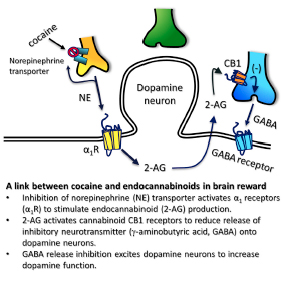Featured Paper of the Month – February 2016
Wang, Huikun; Treadway, Tyler; Covey, Daniel P; Cheer, Joseph F; Lupica, Carl R
Cocaine-Induced Endocannabinoid Mobilization in the Ventral Tegmental Area. Journal Article
In: Cell Rep, vol. 12, no. 12, pp. 1997–2008, 2015, ISSN: 2211-1247 (Electronic).
@article{Wang2015e,
title = {Cocaine-Induced Endocannabinoid Mobilization in the Ventral Tegmental Area.},
author = {Huikun Wang and Tyler Treadway and Daniel P Covey and Joseph F Cheer and Carl R Lupica},
url = {https://www.ncbi.nlm.nih.gov/pubmed/26365195},
doi = {10.1016/j.celrep.2015.08.041},
issn = {2211-1247 (Electronic)},
year = {2015},
date = {2015-09-10},
journal = {Cell Rep},
volume = {12},
number = {12},
pages = {1997--2008},
address = {Electrophysiology Research Section, Cellular Neurobiology Research Branch, National Institute on Drug Abuse, 251 Bayview Boulevard, Suite 200, Baltimore, MD 21224, USA.},
abstract = {Cocaine is a highly addictive drug that acts upon the brain's reward circuitry via the inhibition of monoamine uptake. Endogenous cannabinoids (eCB) are lipid molecules released from midbrain dopamine (DA) neurons that modulate cocaine's effects through poorly understood mechanisms. We find that cocaine stimulates release of the eCB, 2-arachidonoylglycerol (2-AG), in the rat ventral midbrain to suppress GABAergic inhibition of DA neurons, through activation of presynaptic cannabinoid CB1 receptors. Cocaine mobilizes 2-AG via inhibition of norepinephrine uptake and promotion of a cooperative interaction between Gq/11-coupled type-1 metabotropic glutamate and alpha1-adrenergic receptors to stimulate internal calcium stores and activate phospholipase C. The disinhibition of DA neurons by cocaine-mobilized 2-AG is also functionally relevant because it augments DA release in the nucleus accumbens in vivo. Our results identify a mechanism through which the eCB system can regulate the rewarding and addictive properties of cocaine.},
keywords = {},
pubstate = {published},
tppubtype = {article}
}
Cocaine is a highly addictive drug that acts upon the brain's reward circuitry via the inhibition of monoamine uptake. Endogenous cannabinoids (eCB) are lipid molecules released from midbrain dopamine (DA) neurons that modulate cocaine's effects through poorly understood mechanisms. We find that cocaine stimulates release of the eCB, 2-arachidonoylglycerol (2-AG), in the rat ventral midbrain to suppress GABAergic inhibition of DA neurons, through activation of presynaptic cannabinoid CB1 receptors. Cocaine mobilizes 2-AG via inhibition of norepinephrine uptake and promotion of a cooperative interaction between Gq/11-coupled type-1 metabotropic glutamate and alpha1-adrenergic receptors to stimulate internal calcium stores and activate phospholipase C. The disinhibition of DA neurons by cocaine-mobilized 2-AG is also functionally relevant because it augments DA release in the nucleus accumbens in vivo. Our results identify a mechanism through which the eCB system can regulate the rewarding and addictive properties of cocaine.

